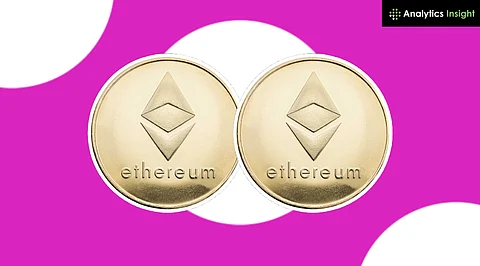

Ethereum whales bought over $265 million in ETH, signaling institutional confidence.
Spot Ethereum ETFs have reached $4 billion in net inflows and $9.29 billion in assets.
Staking, DeFi, and Layer-2 growth are fueling Ethereum’s long-term value case.
Ethereum, the world’s second-largest cryptocurrency by market cap, is once again drawing attention, not because it’s breaking new price records, but because it’s showing remarkable stability amid a broader market pullback. As of June 24, 2025, Ethereum (ETH) is trading at around $2,424, reflecting an 8.17% increase in the last 24 hours, with a market cap of $292 billion and a daily volume of $25.6 billion.
Despite being over 50% below its all-time high of $4,891, investor confidence in Ethereum remains unshaken. Some are doubling down on the belief that Ethereum may be evolving into a modern form of “digital gold.”
On-chain data tells a compelling story: Ethereum whales are actively accumulating. On June 21, large wallets purchased more than 116,893 ETH, valued at over $265 million. According to Lookonchain, the pace of accumulation has been unusually aggressive in recent weeks. On June 12, a record 871,000 ETH was added to whale holdings, marking the highest single-day haul since 2018.
Why does this matter? Whales typically represent institutional investors or seasoned crypto funds. Their moves tend to foreshadow major market trends. Their willingness to buy during a market dip signals a deep belief in Ethereum’s long-term value, even if short-term price action remains volatile.
The launch of U.S. spot Ethereum ETFs earlier this year added a powerful new on-ramp for institutional capital. Notably, on June 11, spot ETH ETFs brought in $240.3 million, outpacing even Bitcoin ETFs that day.
Leading funds like BlackRock’s ETHA, Fidelity’s Ethereum Fund, and Grayscale Ethereum Trust have become go-to vehicles for asset managers and high-net-worth individuals. While weekly inflows have cooled slightly (with $40 million added last week), the consistency of demand highlights Ethereum’s increasing role as a core holding in diversified portfolios.
As of June 23, 2025, ETH spot ETF witnessed a daily net inflow of $100.78 million, bringing the cumulative net inflows to $4.00 billion. The total value traded on the day was $834.14 million, while the total net assets under management reached $9.29 billion, representing 3.28% of Ethereum’s total market cap. These figures underscore the strong and growing institutional demand for Ethereum via regulated investment products.
ETF momentum not only provides price support but also reinforces Ethereum’s legitimacy in traditional financial markets.
Also Read: Ethereum Price Prediction for 2025: Technical Structure, Whale Accumulation, and Market Outlook
Ethereum’s network fundamentals remain robust despite price turbulence. Daily trading volume continues to range between $300 and $490 billion, indicating steady liquidity. Even more impressive: exchange reserves are at all-time lows, and more than 35 million ETH, approximately 27% of the total supply, is now locked in staking contracts.
Meanwhile, decentralized finance (DeFi) protocols like Lido, EigenLayer, Aave, and Uniswap maintain strong activity, with ETH as their primary collateral. Ethereum’s dominance in DeFi, NFT platforms, and decentralized applications underpins its utility-driven demand, something few other cryptos can claim.
Ethereum is not resting on its reputation. The Pectra upgrade, launched earlier this year, enhances validator efficiency and Layer-2 compatibility. Layer-2 solutions like Arbitrum and Optimism have significantly expanded throughput while reducing transaction costs.
Staking innovation is also advancing. Some ETFs are now seeking approval to offer staking rewards, which would provide investors with passive yield, similar to interest on a bond. This potential to earn while holding could make Ethereum even more attractive compared to traditional assets like gold or U.S. Treasuries.
Also Read: Ethereum Comeback Trail: Will This Support Spark a Rally?
Despite bullish fundamentals, risks remain:
Macroeconomic shifts, such as aggressive Fed rate hikes or renewed inflation fears, could trigger risk-off sentiment across markets.
Technical breakdowns below the $2,150 support zone may lead to further declines toward $2,000 or lower.
ETF flows, while positive now, may reverse if broader market sentiment sours or if regulatory headwinds emerge.
However, Ethereum’s wide institutional base, deep liquidity, and protocol activity provide a strong buffer against short-term market shocks.
While Ethereum may not be setting price records today, it is quietly building the case for its long-term relevance. Whale accumulation, ETF inflows, protocol growth, and ecosystem upgrades all signal that ETH remains a cornerstone of the crypto market.
For long-term investors, Ethereum is increasingly being viewed not just as a speculative asset but as a store of value with real-world use akin to “digital gold.” Unlike gold, Ethereum powers decentralized apps, generates yield through staking, and supports a thriving global financial layer.
With its price now more than 50% below its all-time high, many view this as a rare opportunity, not a warning sign.
